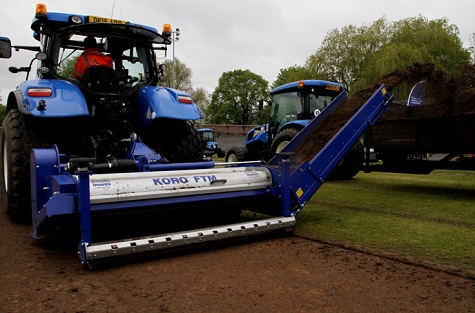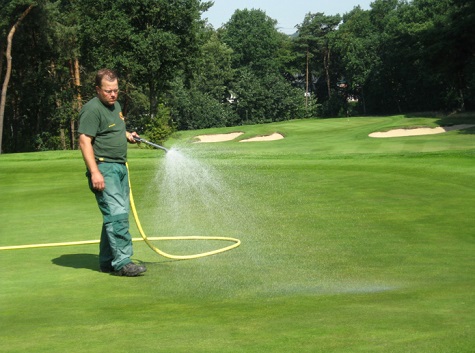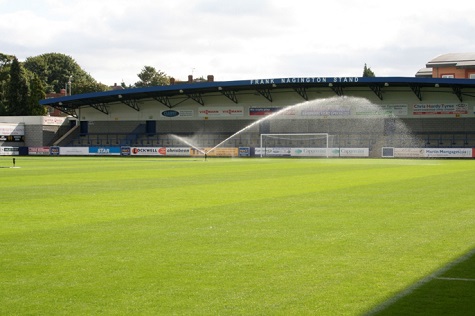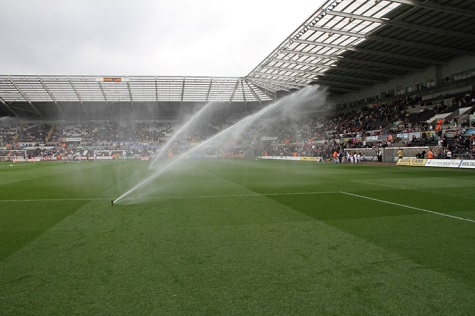We have certainly had a great start to the year, with many ground’s professionals enjoying the recent spell of record-breaking spring weather. This run of fine conditions has helped promote some much-needed grass growth and recovery on our natural grass playing surfaces.
This has been especially appreciated during the recent end of season and pre-season works of rugby football and cricket clubs. As we all know, the grass plant needs plenty of sunlight, water and nutrients to produce the quality swards we desire. I always find it amazing to see how we continue to improve the quality of our playing surfaces with the ever-ongoing technical advancements both in mechanical engineering, biological products and maintenance services.

However, there is still one major factor that always dictates how we work and deliver these exceptional playing surfaces and that is the influence of the weather.
One of the biggest problems facing many groundsmen is the ability to water their natural grass surfaces efficiently, during spells of hot dry weather. The exception to this would be the high-profile professional football clubs, golf courses and top private sports facilities who have the budgets and resources to install effective irrigation systems.
Most if not all grass roots clubs and schools, do not have the means to water their pitches and rely heavily on the weather to provide enough essential water to keep the grass plant alive.
Phil Sharples , a renowned turf professional wrote an interesting article on grass growth and development which is well worth reading.
Having a better understanding of soil / water relationships is a key requirement when trying to grow and maintain grass playing surfaces. Over 90% of the water absorbed by the grass plant is lost through transpiration.
Most transpirational water loss occurs through the leaves, although some may occur through any plant part exposed to the atmosphere. The amount of water contained in a plant at any one time is only a small quantity absorbed and transpired. Nearly all the water lost from the turfgrass plant will be lost through the stomata on the leaves.

The stomata are important structures facilitating the gaseous exchange of CO2 and O2, so vital to photosynthesis. These same stomatal features that enhance efficient gaseous exchange also result in extensive water loss by transpiration. Although composing of only 2 - 3 % of the total turfgrass leaf area, the stomata are responsible for as much as 90% of the total water lost to the atmosphere by transpiration.
The loss of moisture from the soil is termed evaporation. As we have already discussed, loss of moisture from the plant is termed transpiration. Loss of moisture from both the soil and plant is termed Evapotranspiration. As much as 80 - 85% of the soil moisture depletion can be attributed to evapotranspiration.
Water has many important roles within plants and if the water content in the tissue should drop below 60%, the turf is seriously weakened and can die or go dormant. Water is not only essential for growth but necessary for conditioning turf to handle and recover from stress caused by heavy use and harsh environmental conditions.
Supplemental water is necessary when natural rainfall is not sufficient to keep turf healthy after the soils have dried out. Temperature, sunlight, wind, humidity and natural rainfall are climatic factors that help determine the amount of irrigation that is needed.

Having a better understanding of your soil texture (determined by the amount of sand, silt and clay in the soil) influences the amount of water that can be stored and available for plant use. For example, coarse textured soils such as sandy soils have poor water-holding capacity and will need to be watered more frequently than soils with more clay and organic matter which can hold more water.
Irrigation should be supplied to replenish the amount of moisture lost. Deep and infrequent watering, once or twice a week, is preferred unless you are on sand that needs more frequent irrigation.
Water in the early morning and late evenings when the wind is calm. Overwatering may lead to disease problems and thatch development.
Weather; air temperature, daylight hours, solar energy inputs, wind speed and shading are factors that will affect evapotranspiration rates.
Maintenance regimes; keeping the soil open and aerated will increase the drainage capacity of the soil. On the other hand, compacted soils will prevent the movement of water through soils, often creating an environment that prevents water getting down into the soil profile. By carrying out effective regular maintenance regimes that include aeration, scarifying, harrowing, brushing, top dressing all helps to keep the soil in good condition.
Groundsman/Greenkeeper knowledge; it is important that there is someone who understands all the above parameters and can access the water requirements of the turf and correctly implement the right irrigation schedule for the given sport/ facility.
There are three important levels of soil moisture content that reflect the availability of water in the soil. These levels are commonly referred to as: saturation, field capacity, and wilting point. When a soil is saturated, the soil pores are filled with water and nearly all the air in the soil has been displaced by water. The water held in the soil between saturation and field capacity is gravitational water. Frequently, gravitational water will take a few days to drain through the soil profile and some can be absorbed by roots of plants. Field capacity is defined as the level of soil moisture left in the soil after drainage of the gravitational water. Water held between field capacity and the wilting point is available for plant use. The wilting point is defined as the soil moisture content where most plants cannot exert enough force to remove water from small pores in the soil. Most turf grasses will be permanently damaged if the soil moisture content is allowed to reach the wilting point. In many cases, yield reductions may occur long before this point is reached.

So, it is imperative you ensure your sward is kept watered to preventing it reaching wilting point. Today we have an array of techniques and aides to help measure the level of moistures in our soils. Soil water moisture probes or soil water meters can give us meaningful results that help us manage our irrigation needs.
We now also see a wider range of irrigation systems available, from stand alone, self-travelling or boom sprinklers to computer controlled high-tech pop-up gear driven or jet sprinkler systems able to deliver precise amounts of water. Many of the top golf courses have what is called wall to wall irrigation systems designed to irrigate greens, tees, approaches and fairways, enabling the course manager to have full control of his watering requirements.
These systems do use a lot of water, albeit more effectively, so consideration needs to be given to the resource available. Is it mains, borehole, well, river or lake water? In most instances an abstraction licence will be required to obtain this water even though the source may be on club owned land. Irrigation constitutes a major user of water resources at times, and in places, when resources are often at their lowest, such as the summer. Incorrect use of irrigation can lead to a waste of water and, in turn, can cause other problems such as increased drainage water, often resulting in the leaching of nitrates into watercourses with the possibility of pollution.
In recent years the government have introduced a number of laws and regulations regarding the use of water resources. The Water Resources (EIA) Regulations 2003 dictates several issues regarding the use of water, of which the Environment Agency is the main governing body associated with policing the use of water in the UK - along with other agencies such as DEFRA (Department for Environment Food and Rural Affairs). These new laws and regulations will have a significant impact on the way we use and utilise water in the future.
Irrigation management and the optimisation of watering strategies are important to the proper maintenance of sports facilities. Insufficient moisture when soils reach a water deficit will result in a declining quality of sward, or even death. Legislation is going to force the industry to control and manage this scarce resource, therefore the understanding and implementation of an irrigation strategy is a must for all clubs and organisations.